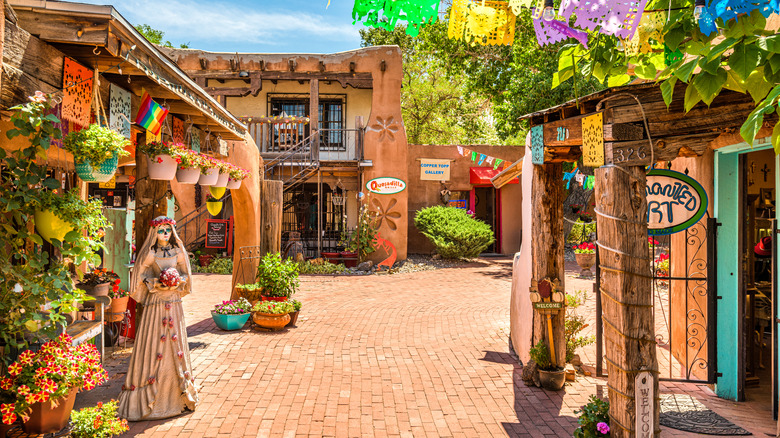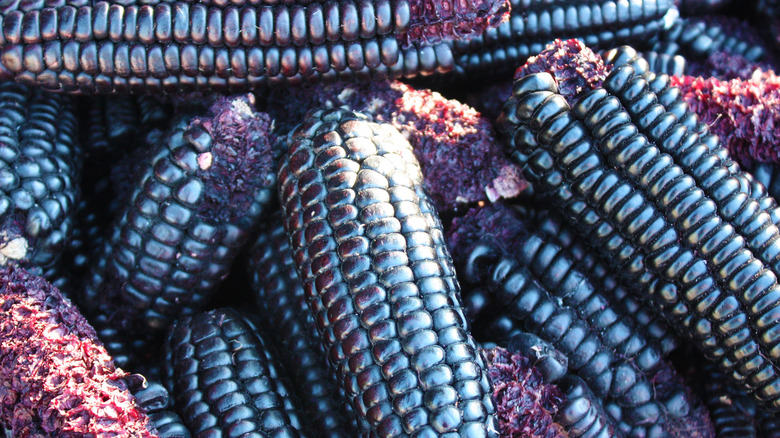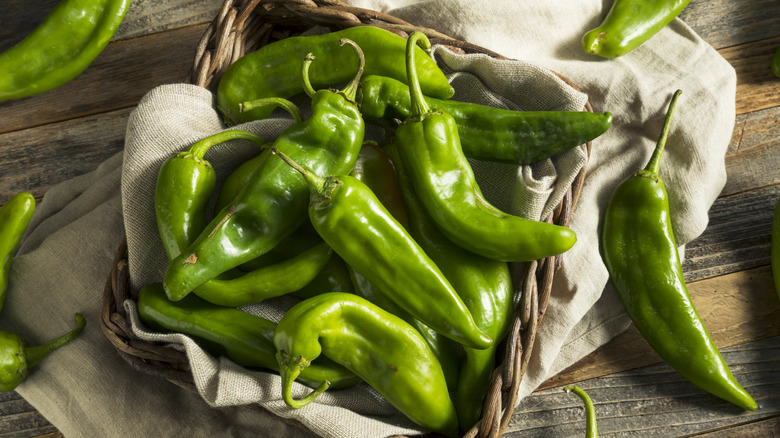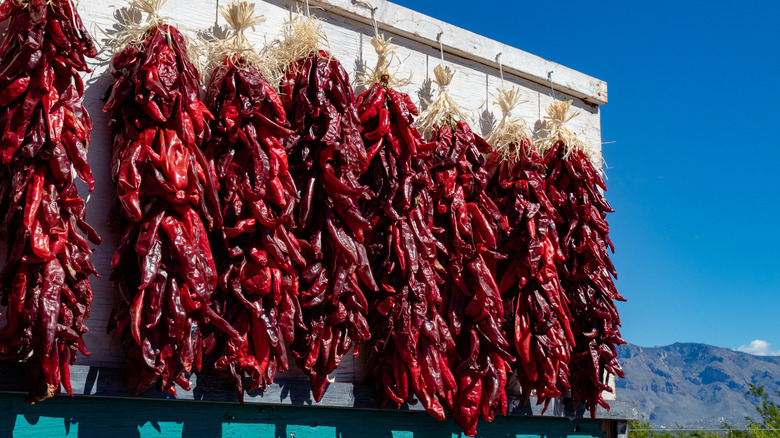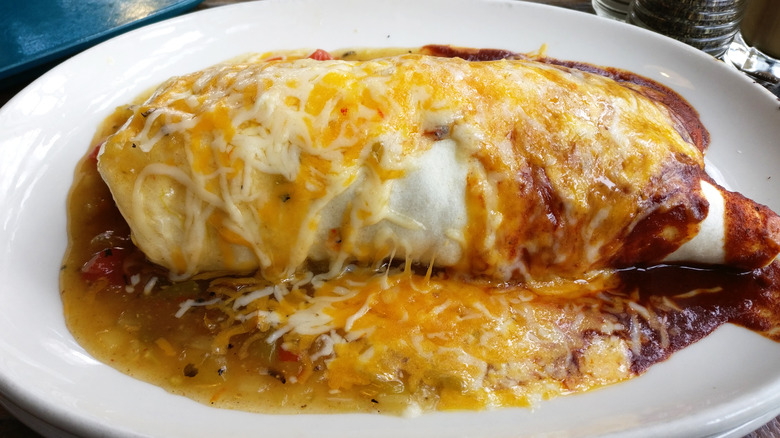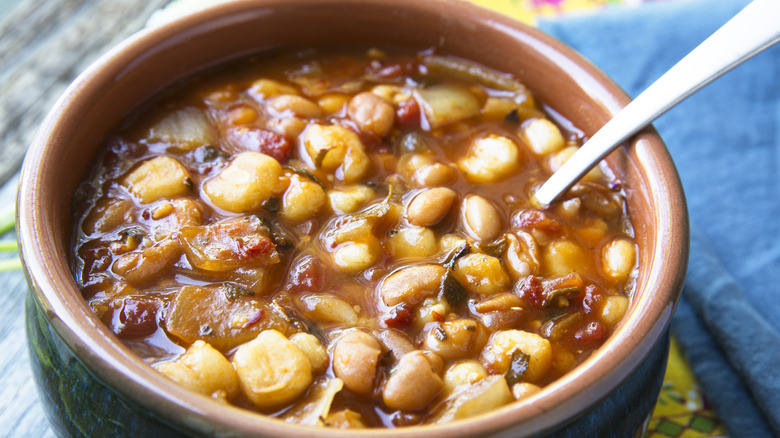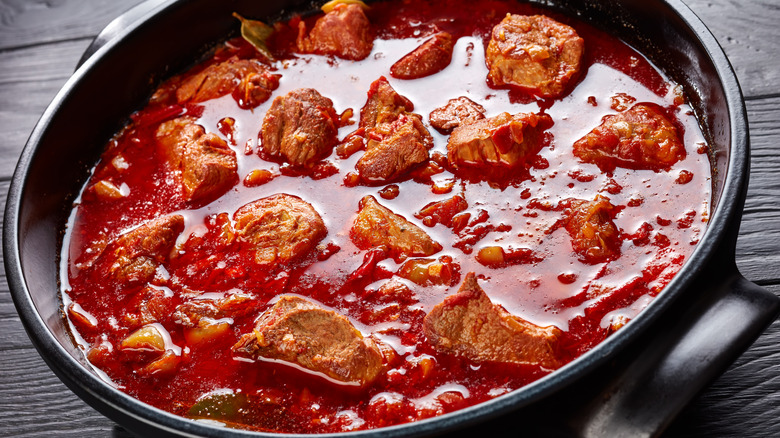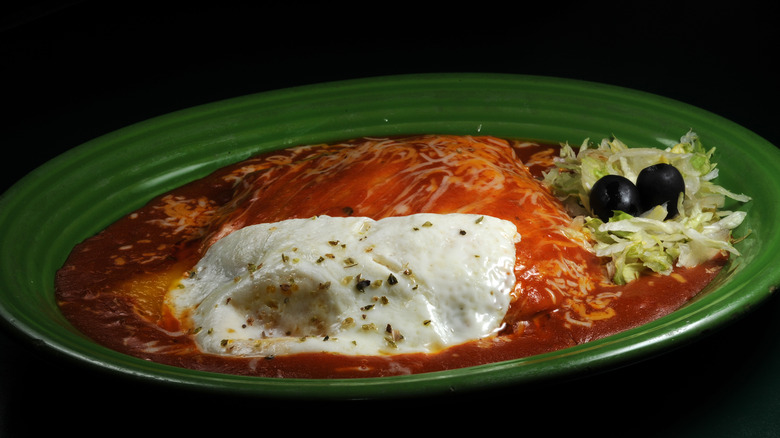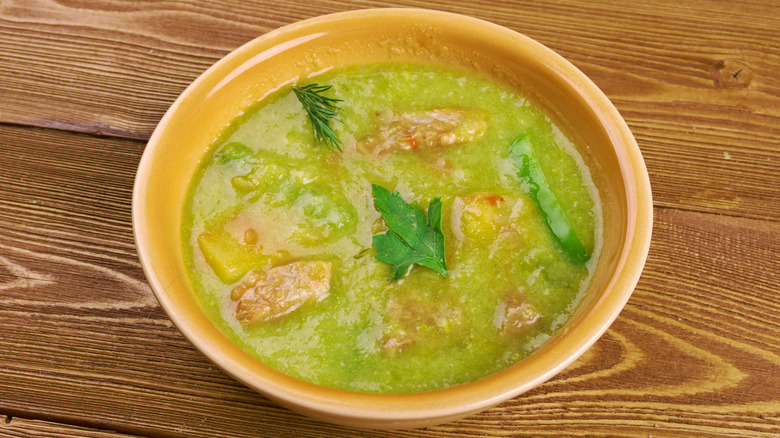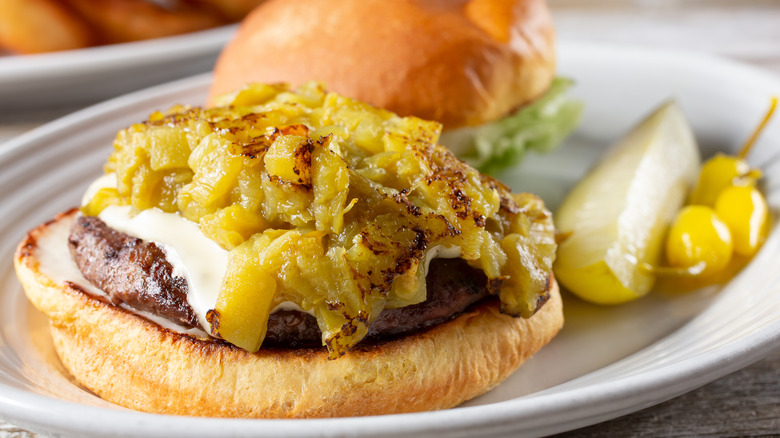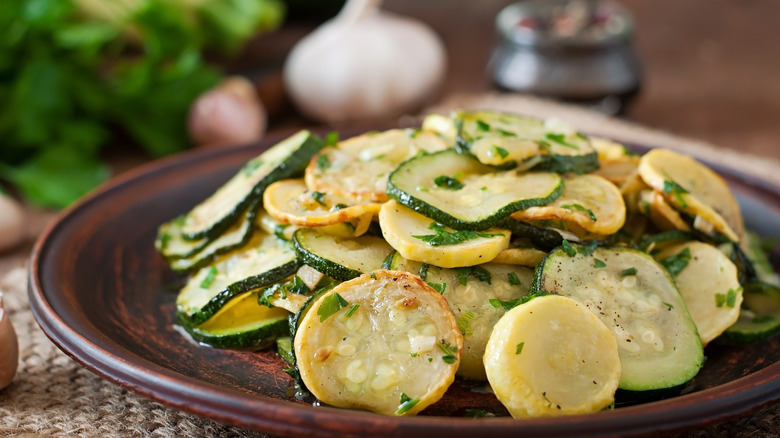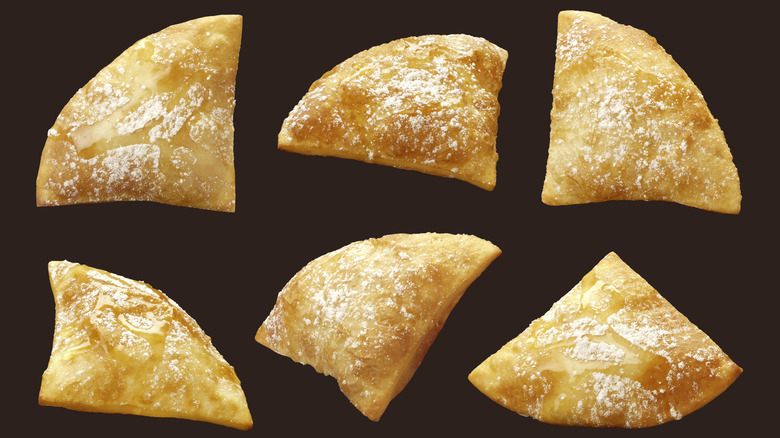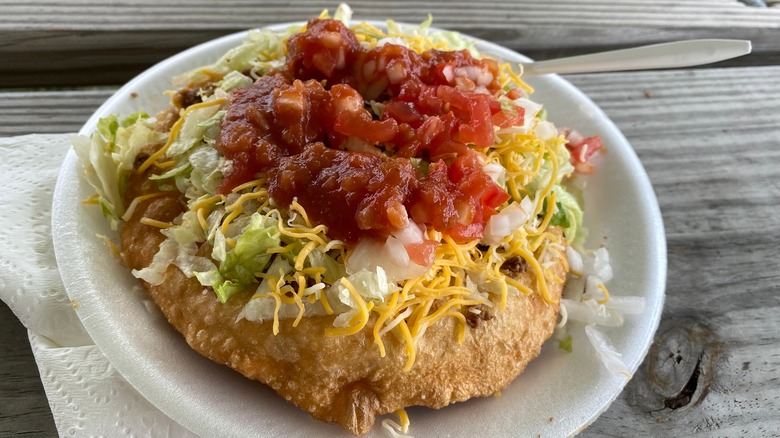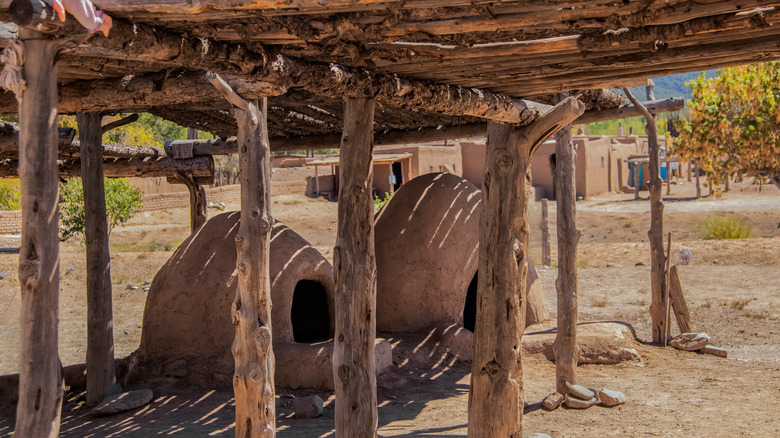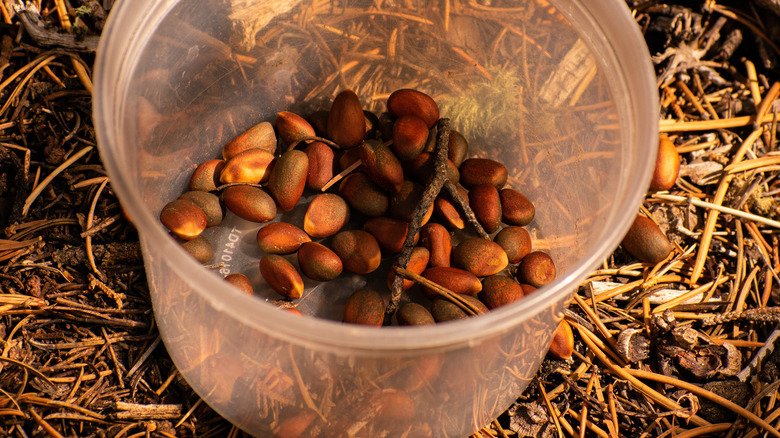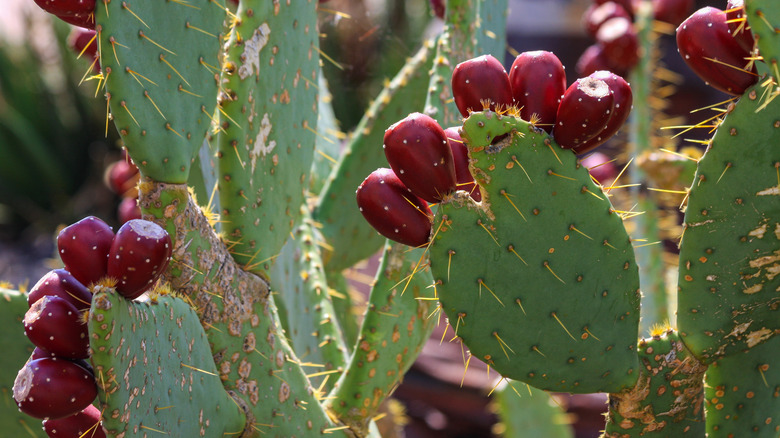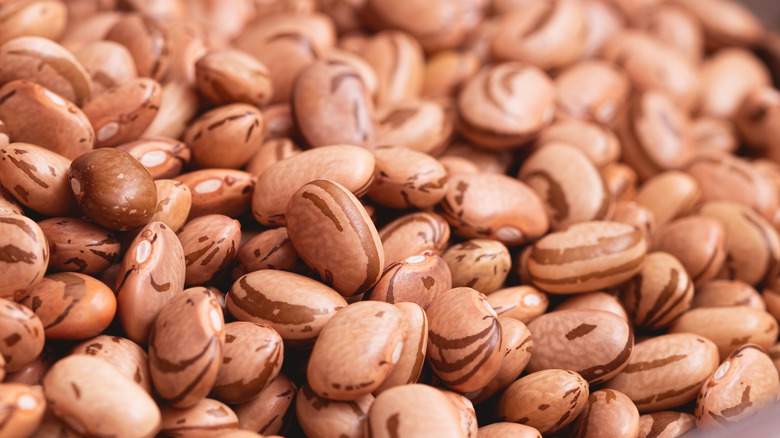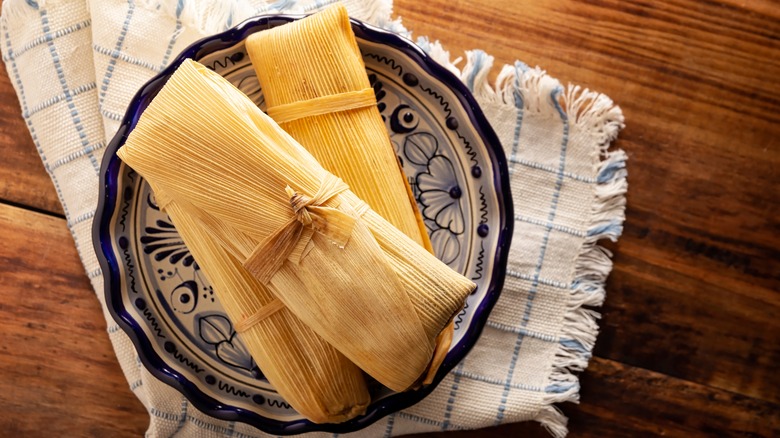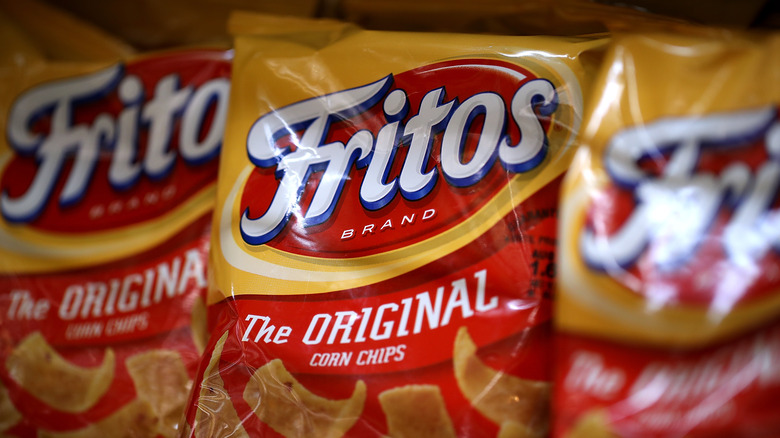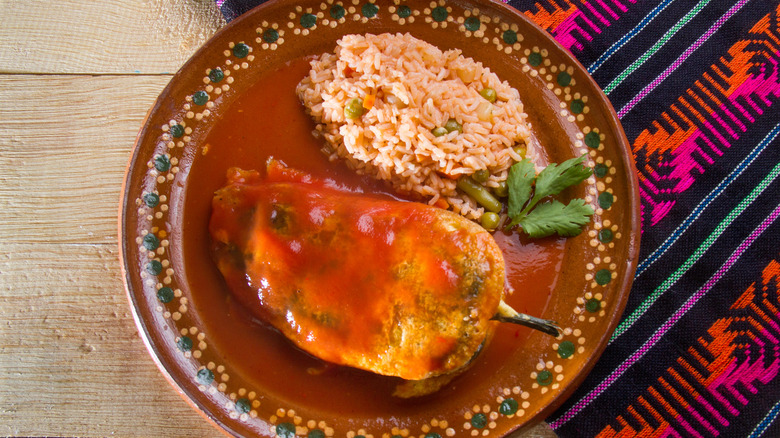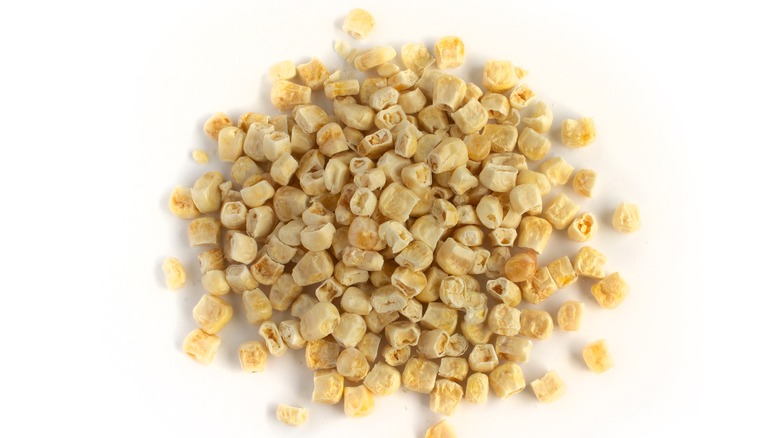21 Foods You Have To Try In New Mexico
Known as "The Land of Enchantment," there is something unique about the food and culture of New Mexico that, all too often, flies under the radar. Perhaps New Mexicans are keen to keep the good stuff to themselves? Significant events have taken place in this part of the world that deserve to be shared as part of the larger American history — the results of which, like with all histories, often find their way onto the dinner table.
Home to high altitudes, the Sandia Mountains, and desert conditions, New Mexican agriculture is celebrated for its endurance. Much of the local culture is thanks to Native American and Indigenous groups who have called this land home long before the Spanish settlers arrived. Now these traditions are mixed with Spanish and Mexican cultures, resulting in a rich culinary heritage and widely celebrated arts community throughout the state. For real or armchair travelers, New Mexico has plenty of much-loved foods you should know about that speak of the land, history, and people themselves.
Ancient blue corn
Corn is a significant staple of Indigenous peoples in the Americas, present both in a variety of foods and dishes as well as within cultural rituals and spiritual beliefs. Blue corn was first grown in Mexico around 9000 years ago, eventually making its way into the Southwest. It is by using dried corn, or maize, that nixtamalization occurs — a longstanding traditional process during which the corn is mixed with calcium hydroxide or ash to produce more digestible and highly nutritious foods (via International Maize and Wheat Improvement Center.)
Blue corn is a unique variety of flint corn cultivated by a number of Native communities, including the Hopi, which make dishes such as piki bread, and Acoma Pueblo cultivating blue corn for sweet and savory dishes. Blue corn is thought to be more nutritionally dense than other varieties and is still a source of pride for many New Mexicans. The Guardian reports the program director for non-profit Ancestral Lands Aaron Lowden is part of a larger food sovereignty movement determined to preserve the tradition of ancient blue corn agriculture and production in Indigenous and New Mexican culture.
You can try just about everything made from blue corn including corn pancakes, tortillas, atole, and blue cornbread using a cast iron!
Green Hatch chiles
New Mexicans take chiles so seriously that it became an official state question — Red or Green — in reference to your preferred chile sauce. The best answer when asked is "Christmas," meaning both. As journalist Gowri Chandra reports in Whetstone Magazine that despite the state's proximity to South America, chiles were not in fact a pre-colonial food in the area. Chandra also finds the chile is named after the valley of Hatch, New Mexico, where the variety was first grown commercially.
Hatch chiles are known for a buttery and earthy flavor, with a medium level of heat ranging from 1000-8000 Scoville heat units. The heat is enough to make eating large quantities possible. Chiles in New Mexico have also been developed into numerous varietals with varying heat levels.
Green chile harvest is between late August through until early October. New Mexicans are known to buy these freshly roasted chiles in bulk, storing them in freezers to use throughout the year. And, just in case you thought otherwise, green chiles aren't just allocated to New Mexican foods — they're everywhere from milkshakes to hatch chile mac and cheese recipes.
Red chiles
It's hard to picture a New Mexican home without conjuring an image of an adobe-style house adorned with at least one brick red ristra, a bundle of strung red chilé de arbol pods, left to dry in the desert sun. Ristras, a symbol of hospitality and welcoming, are also a very practical way of keeping chiles for later use in the kitchen. The efficacy of storing them this way is down to the state's desert conditions and lack of humidity.
There are a variety of red chiles to try ranging in heat levels. Chimayó is one of the most popular and is grown near the sacred area. Chef Michelle Chavez says the chimayó "really take on a flavor from the sun" in New Mexico Magazine.
When using the dried chiles to make red chile sauce, you'll want to first toast them in a hot, dry pan until fragrant, then soak in hot water to soften them, remove the seeds and stems and blend with hot water or stock, garlic, and onion. They can also be ground to make a flavorful chile powder.
Breakfast burritos
New Mexico's 50-stop breakfast burrito trail pretty much seals the deal that this is a must-eat dish when visiting the Land of Enchantment. Santa Fe New Mexican reports the term "breakfast burrito" is all thanks to a small family-run restaurant called Tia Sophia's in Santa Fe in the 1970s. This much loved item has become a classic staple throughout the state, with each restaurant and region adding its signature twist.
For the grab-and-go variety, chile, potatoes, eggs, cheese, and a variety of other options are tucked inside a flour tortilla. For those who prefer to dine in, consider this the key to unlocking the world of New Mexican foods smothered in a serotonin-producing, tongue-tingling, sweat-inducing chile sauce. Frontier is an Albuquerque institution known for its tortillas, eclectic crowds, and thematic dining areas.
Want to learn more about chile's place in the Santa Fe food scene? "Cooking in America" with Sheldon Simeon spoke with guest chef Clifford Endo, who says there are two truths to New Mexican cuisine: You can put chile on everything, and you can put anything into a tortilla.
Posole stew
Posole or pozole, depending on your preferred spelling, is a stew made from kernels of hominy flint corn that is dried and soaked in a sodium carbonate or wood ash to nixtamalize before the outer layer is removed. The resulting hominy kernels are kept whole to make this warming and nourishing stew.
Warming, flavorful, and designed to feed a crowd, many New Mexican homes turn to this dish in winter for comfort. Posole, alongside tamales, and bizcochitos, are also often a part of a traditional New Mexican Christmas feast (via Albuquerque Journal.)
Hominy and posole both have origins in pre-colonial Indigenous Mexican communities like the Aztecs, says Masterclass. The state of New Mexico has the second highest percentage of people with Native American heritage and over 48% identifying as Hispanic, according to the World Population Review. Though the traditional posole recipe is made with dried hominy and pork, other meats and vegetarian versions have also been adapted. This stew has also incorporated other cultures and flavors (like this Posole rojo with matzo balls), even if though nothing replaces the original.
Bizcochitos or biscochitos
The winter holiday season in New Mexico is a fully immersive experience. Just as the air is distinctly permeated with the smells of roasted chiles in late summer in early autumn, around Christmastime, New Mexican towns are filled with the smells of star anise, cinnamon, cedar, and piñon.
Known as the official state cookie as of 1989, bizcochitos (also spelled biscochitos) are an adaptation of a Mexican wedding cookie and a Spanish cookie called Mantecados. Tracing the New Mexican occupation back to the Spanish, who moved through Mexico, we can see how both cultures have helped to formed the regional cuisine through foods like the bizcochito that distinctly reflect New Mexican history.
Bizcochitos, like their Spanish and Mexican counterparts, are traditionally made with lard, creating an incredibly soft melting texture peppered with warming aromatics of cinnamon and star anise. They often make an appearance at any milestone or celebration, but are especially beloved during the winter months. Their incredibly distinctive texture, smell, and taste evoke feelings of warmth, celebration, and comfort.
Carne Adovada
You would be remiss to visit the state of New Mexico and not try a bowl, plate, or tortilla filled to the brim with tender pork, slow-cooked in a red chile sauce. Deeply comforting and bursting with a citrusy and fruity heat, this is the carne adovada, New Mexico's answer to the delicious Mexican dish carne adobada.
Carne adovada is an anytime food in New Mexico. While variations are plentiful, its foundation includes pork, garlic, vinegars, and oregano. The pork is often either cubed before marinating or prepared as a whole shoulder and then shredded (via Cooks Illustrated). Carne adovada can be found served over eggs, in a burrito, alongside slow cooked pintos and Spanish rice, or smothered with cheese on a plate of enchiladas.
It is a unifying dish (provided you eat meat) both as a home-cooked dish and one eaten when dining out. Preparations are straight-forward and ingredients are local enough to be incorporated into domestic cooking across the state. Yet, this is dish is so ubiquitous with the state's pride and sense of identity that it is also found just as easily and proudly on the menus of coffee shops, mom-and-pop spots, and James Beard awarded establishments.
Stacked or flat enchiladas
We're not sure if there is anything quite as comforting, or as tasty, as a plateful of enchiladas. The New Mexican version is different from the rolled and baked casserole enchiladas many are familiar with — those can be found here, too.
Much like the kinds of enchiladas found in Northern Mexico, stacked enchiladas are put together one-by-one: first frying corn tortillas to soften or crisp them up (depending on your preference) before topping with meat and cheese then baking just long enough for the cheese to melt. Stacked enchiladas are at their best when served immediately, so as not to get soggy, and preferably topped with red chile sauce and a fried egg.
According to Only In Your State, having to ask what a stacked enchilada is, or where to find them, is a tell-tale sign you're not a local. And while being a tourist isn't a bad thing, it's always great to visit with an idea of the local cuisine so you can fully immerse yourself in the environment and well-loved foods. Just look for the words "stacked" or "flat" next to enchiladas on a menu.
Green chile stew
Every culture has its "cure-all" soup recipe to help soften the pain of life's ailments, from congee to chicken noodle soup. In New Mexico, whether you're fighting a cold or heartbreak, a bowl of green chile stew is often the first recommendation for what ails you. In "Cooking in America," chef Clifford Endo calls green chile stew the "New Mexican Robitussin."
Green chile stew, a New Mexican take on a Mexican Caldillo, is one of those dishes that everyone has their own preferred version. Known for being a Northern New Mexican dish, Frommers explains the base ingredients include some form of meat, typically pork or beef, potatoes, and a green chile and garlic laced broth. The longer the broth cooks, the richer the flavor and deeper the feelings of comfort. The green chile is, of course, the star of the show. Thick or thin, spicy or mild, there are as many versions of this comfort food as there are stars in the New Mexican sky.
Green chile cheeseburger
Like many food origin stories, often there is no clear distinct "origin," but rather a simultaneous effort made by a number of communities to bring an ingredient into the public eye. Such is the case with the green chile cheeseburger. As New Mexico Magazine notes, Owl Bar & Café does make a relatable argument in claiming its part — any excuse not to wash extra dishes! It's neighbor Buckhorn Tavern's green chile cheeseburger has been labelled a "must-eat" by multiple publications, making U.S. 380 in San Antonio the number one place to scratch your chile-cheeseburger itch.
Blake's Lotaburger claims to be the first restaurant chain to add green chile onto the menu in 1952. Now you can find it just about everywhere that sells burgers. Even fast-food chains like McDonalds makes this special burger in its New Mexico locations. There's even a 63-stop Green Chile Cheeseburger Trail, designed by James Beard Award Winner Cheryl Alters Jamison.
Although the true origins of the green chile cheeseburger might remain forever murky, one thing is certain — it is a must-try when visiting New Mexico. Not just for meat eaters, a green chile and black bean burger recipe is also delicious when topped with the good stuff.
Calabacitas
A trio known as the Three Sisters, corn, beans, and squash, when planted together, grow in harmony helping to protect and support each other. It's a prominent and celebrated form of companion cultivation practiced in Indigenous communities in New Mexico (and well beyond). Given both the prominence of Pueblos and Native communities in New Mexico, and conditions that support these crops, many New Mexican foods will contain at least one of the Three Sisters. Organizations like Native Seed Search is dedicated to helping keep these Indigenous growing traditions and knowledge alive.
Calabacitas is a much-loved simple New Mexican side dish is a much-loved simple New Mexican side dish if for nothing else than it uses up the glut of calabacín, or summer squash. Like so many other dishes in this region, it draws from both Mexican and Native American foodways. Depending on who is making it the dish is also known to include corn and, of course, green chile. It is New Mexico, after all.
Sopapillas
You would be hard pressed to sit down at any New Mexican or Mexican restaurant in the state and not be offered a complimentary sopapilla with your meal. Sopapillas are deliciously puffy, deep-fried squares or triangles of dough — the perfect antidote after too much spice. A fresh basket of sopapillas brought to your table will often be accompanied by a jug or squeezy bottle of honey.
The trick is to carefully (they're hot!) nibble or tear off one of the corners of the fried dough, then drip honey along the hot side of the interior before devouring immediately. If a complimentary sopapilla with honey isn't enough of a desert for you, there are also often more decedent options available, including filling or smothering the deep-fried dough with ice cream and sauce.
Notably, however, when it comes to New Mexican cuisine, sopapillas are not just reserved for desert alone! As the New Mexican Nomad points out, at a wide number of restaurants, including local Santa Fe and Albuquerque favorite Tomasitas, sopapillas are also served stuffed like a burrito or taco with meat, beans, and cheese as a main entrée. If you're wondering if a complimentary sopapilla comes with your sopapilla, the answer is most likely yes. There is no such thing as too many in New Mexico.
Frybread
Frybread has a history deeply rooted in colonization, trauma, and resilience for many Native American peoples. Smithsonian Magazine says frybread was created using the new, government-issued foods of flour, lard, and sugar as a means of survival. It is the original product of the Diné or Navajo community following their displacement and attempted genocide at the hands of the American government, known as "Hwéeldi" or "The Long Walk."
Despite this complicated history, or perhaps because of it, Smithsonian Magazine says frybread often makes an appearance at intertribal ceremonies and celebrations. You will find frybread served on its own or with toppings, such as a variation known as an Indian Taco or Navajo Taco, which will include savory taco toppings like ground beef, beans, cheese, tomatoes, and lettuce.
Though there may be many places throughout the state making frybread, we think it's best eaten and purchased from a Native-owned business. Coordinate a trip to New Mexico during one of the many feast days or powwows through the Indian Pueblo Cultural Center. You can also visit Saya's Fry Bread and Indian Tacos, a self-claimed first and only Native-owned food truck in Santa Fe to get your frybread fix at any time of year.
Pueblo or horno bread
The name Pueblo bread, or horno bread, references the outdoor cooking ovens called hornos in which the breads are cooked. Like fry bread, this baked good comes with the difficult complexities of colonial history of the New Mexico, alongside Pueblo resilience. Pueblo bread is made using wheat flour, milk, and lard — all ingredients introduced by Spanish colonizers in the 1500s (via New Mexico Magazine).
However, Pueblo bread differs from frybread because it is baked in traditional outdoor domed ovens made from clay. Pueblo bread, chiles, and stews made in a horno are cooked using burning fragrant wood like cedar, which evokes the smells and tastes of the local land, a prevalent theme within New Mexican cuisine. The use of hornos is common during Pueblo feast days but is not reserved to just special occasions. You would be remiss to visit the state and not experience the traditions and tastes of this cooking process.
Piñon nuts
The Santa Fean explains that piñon trees are an indigenous species to the Southwest and are part of a state-wide tradition across Hispanic and Indigenous cultures to forage, roast, and eat the nuts. The site says the nuts can be eaten as a snack without any cooking at all, much like sunflower seeds, or roasted and cooked into a variety of dishes including coffee, baked goods, and savory items.
Officially dubbed the New Mexico state tree, the piñon nut is said to deliver a punch of healthy fats. According to New Mexico Magazine, the nut has as much protein as beef, making it a nutrient rich addition to whatever dish you want to add it to. The Counter reports that due to increasing climate change and drought, a notable decrease in the growth of Piñon trees has some worried about what this will mean for the future of this much loved tradition.
Prickly pears
Prickly pears are the vibrant and juicy buds or pods that form on top of cactus paddles or nopales. Prickly pears are another native food to New Mexico that makes up the backbones of the state's unique culinary practices. Both pods and paddles are edible and highly nutritious. According to Healthline, prickly pear pods, called tunas, are rich in vitamin C, dietary fiber, and antioxidants.
Although harvesting prickly pears can be somewhat of an undertaking, given the cactus needles and sticky exterior, the flavor alongside added health benefits makes harvesting worth the efforts. New Mexico Magazine recommends wearing protective gear to safely harvest the fruits.
Floral and fruity and often compared to the flavor of watermelon, prickly pears are most commonly cooked down into syrups, added to margaritas, made into jelly, or used to create scented soaps. So treasured are these cactus fruits within New Mexico that there is now an annual Prickly Pear Fest, which showcases the many uses, benefits, and small businesses that are celebrating these native and sustainable ingredients.
Pinto beans
Pintos are another much loved crop native to New Mexico, which has been feeding New Mexicans in the best and worst of times for years. You can almost guarantee any beans option on a menu in New Mexico will be derived from pintos. Not just in restaurants, you would be hard pressed to walk into a New Mexican home kitchen and not find a pinto, either dried or canned, along with a set of preferences or methods passed down within the family on how best to enjoy them.
So popular, so omnipresent and well grown throughout the state that despite their legume status, pinto beans are considered one of the two state vegetables, according to New Mexico Magazine. Pinto beans are often grown, cooked, and served alongside one or more of the three sisters. Classic New Mexican dishes include a bowlful of chicos with pintos or frijoles de la olla, which are always served alongside a tortilla and a helping or two of chile.
Tamales
Given tameles longstanding history, we could consider tamales one of the first to-go foods, known for portability and taste. Tameles are a tender, masa-filled parcel that is as versatile and labor-intensive, as it is delicious.
Tamales are both an everyday and a special occasion food in New Mexico. A traditional New Mexican Christmas feast would be remiss without some tamales on the table. They are as essential to a New Mexican Christmas as the wafting smells of bizcochitos baking, and the flickering candle-lit, sand-filled bags known as luminarias or farolitos (depending on what part of the state you live) that the adorn paths toward adobe homes.
To taste some of the best tamales in the state, visit the much loved local favorite El Modelo in Albuquerque, known by locals for its giant tamales since 1929. Alternatively, try the highly recommended Teresa's Tamales in the town of Cleveland, New Mexico. You can also create your own tamale trail around the holidays or any time of the year.
Frito pie
Frito pie is a much-contested dish. Frito pie's New Mexican origin story is contested by both Texas and by the late, great Anthony Bourdain. No matter, it is still a much-loved dish in the state. Whether it is originally from New Mexico or not, Frito pie has become woven into the culture around the state. "It is such a New Mexican food now," says food author Lynn Cline in New Mexico Magazine, while chef Rocky Durham of Santa Fe says, "It's messy, accessible, inclusive, and classless."
Think of it as a cross between chili and nachos — the combination of rich meat merged with salty, crunchy Fritos and topped with cheese and red chile. It's best when all the ingredients are ladled right inside the bag itself. Where the creator of Fritos was from, it doesn't change the culture around this dish and that the Santa Fe Five & Dime, previously Woolworths, is known for popularizing this popular dish in the late-1960s. Now, even Blake's Lotaburger has its own version.
Chiles rellenos
Originating in Puebla, Mexico, chiles rellenos are a savory snack or appetizer consisting of roasted peppers stuffed with meat or cheese before being fried. They are most commonly made using poblano chiles. However, given the Hatch-loving hearts of New Mexicans, it's no surprise to hear that the dish in this area is most commonly made from one of the many spicier, local green chile varieties.
New Mexico Nomad calls chile rellenos a "jalapeño popper on steroids." As New Mexico Nomad notes, the state's Big Jim green chile, which was originally cultivated in the '70s through New Mexico State University, makes for a great relleno option given its standard length of between 7-9 inches. Given the amount of preparation involved in making chiles rellenos, this dish might seem like primarily a restaurant dish. However you can just as easily find it being made in homes and a party of family cooking.
If you can't find rellenos where you are, you can always attempt to make a chile relleno breakfast casserole out of the much-loved dish. Maybe switch out the chiles for something spicier if you're feeding a New Mexican.
Chicos
You really can't get much more New Mexican than chicos. It is the epitome of New Mexican home cooking. Though the dried corn is prevalent throughout the Southwest, the name might just be a New Mexican thing, according to Slow Food Foundation for Biodiversity.
Chicos are the results of first steaming, then drying out and dehydrating ears of sweetcorn. Th foundation explains this drying process traditionally takes place inside a wood-burning horno, using local cedar wood to infuse an irreplaceable smoky flavor into the sweet-tasting kernels. New Mexico Magazine find the unique flavor tastes of the land itself, presented in a humble, unhurried nature that is often associated with New Mexican pace of life.
Once cooked and dried, chicos are then rehydrated when used in a dish, often in stews, most commonly alongside pinto beans and sometimes ham hock or pork. Chicos can also be rehydrated and sprinkled into calabacitas, again working to reunite two of the harmonious three sisters.
